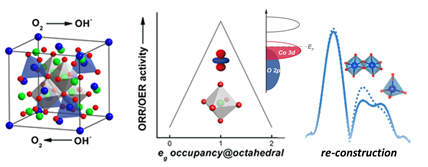

报告题目:Oxygen Electrocatalysis on Transition Metal Spinel Oxides
报告人:Prof. Zhichuan Xu(新加坡南洋理工大学)
报告时间:2019年5月17日(周五)上午10:40-11:40
报告地点:华南理工大学大学城校区B5-102会议室
欢迎广大师生参加!
报告人简介:

Zhichuan is an associate professor in School of Materials Science and Engineering, Nanyang Technological University. He received his PhD degree in Electroanalytical Chemistry at 2008 and B.S. degree in Chemistry at 2002 from Lanzhou University, China. His PhD training was received in Lanzhou University (2002-2004), Institute of Physics, CAS (2004-2005), and Brown University (2005-2007). Since 2007, he worked in State University of New York at Binghamton as a Research Associate and from 2009 he worked in Massachusetts Institute of Technology as a Postdoctoral Researcher. Dr. Xu is member of International Society of Electrochemistry (ISE), The Electrochemistry Society (ECS), and American Association for the Advancement of Science (AAAS). He was awarded Fellow of Royal Society of Chemistry (FRSC) in Nov. 2017. He served as a guest editor for the special issue ICEI2016 of Electrochimica Acta and an associate editor for Nano-Micro Letters. He is also the development editor for Current Opinion in Electrochemistry and the vice president of ECS Singapore Section. Dr Xu is 2018 Highly Cited Researcher by Clarivate Analytics, Web of Science.
报告摘要:
Exploring efficient and low-cost oxygen electrocatalysts for ORR and OER is critical for developing renewable energy technologies like fuel cells, metal-air batteries, and water electrolyzers. This presentation will present a systematic study on oxygen electrocatalysis (ORR and OER) of transition metal spinel oxides. Starting with a model system of Mn-Co spinel, the presentation will introduce the correlation of oxygen catalytic activities of these oxides and their intrinsic chemical properties. The catalytic activity was measured by rotating disk technique and the intrinsic chemical properties were probed by synchrotron X-ray absorption techniques. It was found that molecular orbital theory is able to well-explain their activities. The attention was further extended from cubic Mn-Co spinels to tetragonal Mn-Co spinels and it was found that the molecular theory is again dominant in determining the catalytic activities. This mechanistic principle is further applied to explain the ORR/OER activities of other spinels containing other transition metals (Fe, Ni, Zn, Li, and etc.). The talk further gives insight on surface reconstruction on spinel oxides and how the bulk properties affect such reconstruction during OER.

Figure 1. A simple demonstration of spinel structure, the activity descriptor, and bulk thermodynamics determined surface reconstruction.
Reference
Wei C, Feng Z, Scherer G, Barber J, Shao-Horn Y, Xu Z, Adv. Mater. 2017, DOI: 10.1002/adma.201606800.
Suntivich J, May KJ, Gasteiger HA, Goodenough JB, Shao-Horn Y, Science 334 (2011) 1383.
Zhou Y, Sun S, Xi S, Duan Y, Sritharan T, Du Y, Xu Z, Adv. Mater., 2018, DOI: 10.1002/adma.201705407
Zhou Ye, Sun S, Song J, Xi S, Chen B, Du Y, Fisher A, Cheng F, Wang X, Zhang H, Xu Z, Adv. Mater. 2018, DOI: 10.1002/adma.201802912
Yan Duan, Shengnan Sun, Yuanmiao Sun, Shibo Xi, Xiao Chi, Qinghua Zhang, Xiao Ren, Jingxian Wang, Samuel Jun Hoong Ong, Yonghua Du, Lin Gu, Alexis Grimaud, Zhichuan J. Xu, Adv. Mater., 2019, 1807898
Shengnan Sun, Yuanmiao Sun, Ye Zhou, Shibo Xi, Xiao Ren, Bicheng Huang, Hanbin Liao, Luyuan Paul Wang, Yonghua Du, Zhichuan J. Xu, Angewandte Chemie International Edition, 2019, DOI: 10.1002/anie.201902114




